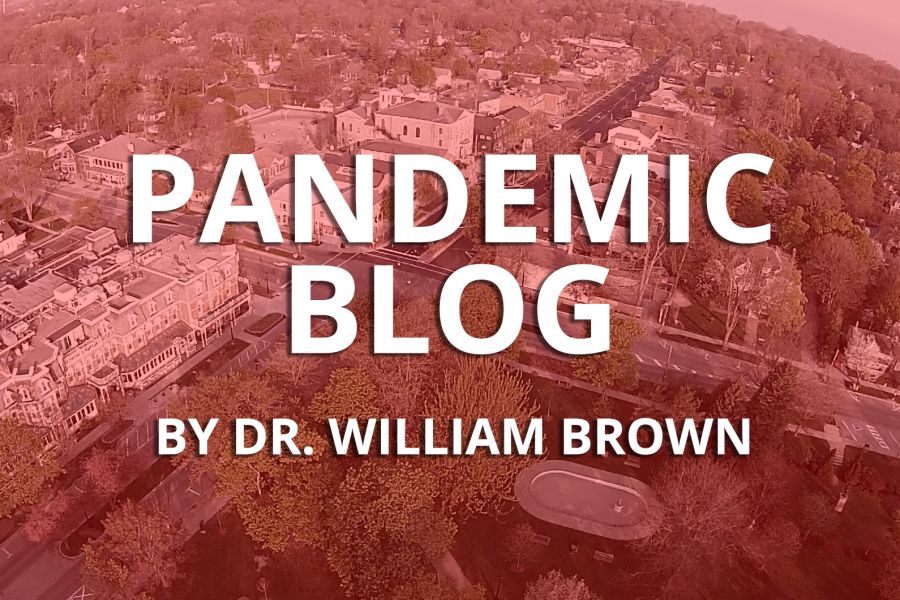Dr. William Brown
Special to The Lake Report
The genome of the COVID-19 virus (SARS-Cov-2) is small – only 30,000 bases in its single strand of RNA compared to the 3.2 billion bases in a single strand of human DNA.
Yet in the five months since it was first discovered in China in late November last year, this virus wreaked havoc first in Wuhan, then much of the rest of China, later Iran, much of Europe, the United States and now over 100 countries – along the way infecting millions and killing many thousands. And there is worse to come in poor countries where there’s little in the way of health care and social distancing is impossible.
This virus, like many others, gains access to the interior of cells, by latching on to specific receptors embedded in the membranes of cells – in this case ACE-2 receptors. Then the virus’s genome sets about usurping the cell’s own machinery for copying proteins and RNA, to make thousands of copies of itself, destroying the cell in the process and releasing the copies into the circulation to infect other cells.
Favoured targets of this virus include the lining cells of the respiratory tract, especially the epithelial cells, which line the hundreds of thousands of tiny alveolar sacs and their associated capillaries, where gas exchange normally takes place. Other sites rich in ACE-2 receptors, such as the vascular system, kidneys, epithelial cells in the bowel and cells in the brain, are also prime targets for this virus.
Given the target tissues of this virus, it’s not hard to guess what the clinical manifestations might be. Sneezing, coughing and pneumonia for the respiratory system, heart attacks, arrhymias, heart failure, hypotension, ischemic stroke and changes in the fingers for the vascular system, diarrhea and vomiting for the gastrointestinal system, kidney failure for the urinary system and clotting for the hemopoietic system. The common denominator: they all have lots of ACE-2 receptors.
So far at least 30 pharmaceutical companies and government-supported ventures are working on vaccines using traditional methods employing killed or tamed COVID-19 viruses or higher-tech methods designed to use selected bits of the virus to provoke a more vigorous, targeted and effective immune response.
Just days ago, Moderna, a Massachusetts-based company, released encouraging results from the first phase of studies of its vaccine. Hopefully that vaccine and promising ones produced by other companies will be fast-tracked through the clinical testing process to shorten what would otherwise be a year-long or longer time required for approval.
Just as important will be to develop the requisite manufacturing processes for mass producing the most effective vaccines for what will be a worldwide market. Hopefully, the development of effective antiviral agents can be fast tracked, too.
But what if the current version of COVID-19 proves capable of reinventing itself to get around any of the vaccines in development? Prior experience with the coronavirus family isn’t encouraging.
For example, colds are caused by coronaviruses and what immunity might develop following one cold doesn’t seem to last very long or the virus mutates to get around the immune responses to previous infections. In the case of the closely related SARS-Cov-1 virus, naturally acquired immunity didn’t appear to last much past two years. What about COVID-19? We don’t have an answer to that yet.
We know that COVID-19 has mutated within and beyond China, but as far as we can tell, not in a fashion that would change the transmissibility of the virus or the clinical features of the disease. So far most of the mutations documented in this pandemic have taken place in non-critical regions of the virus’s genome with no apparent effect on the virus’s infectivity or behaviour.
There are other regions of the virus’s genome where there have been few, if any, mutations, which suggests these regions may be highly conserved and that any mutations in these regions, might be fatal for the virus. That would make these conserved regions of the virus’s genome a natural target for the development of antiviral drugs and possibly a vaccine.
Despite worldwide dissemination of the disease and plentiful opportunities to make copying errors, this virus appears to mutate slowly – half the rate at which seasonal flu mutates, even though its genome is twice the length of the flu genome. That’s reassuring because it suggests this virus might not find a quick way around any effective vaccine or antiviral drug – once we have them.
We’re still learning about this virus, but so far, its behaviour suggests that we might be dealing with it for a long time: hence an effective vaccine is essential if we’re ever to get on top of this phase of the pandemic and possible recurring waves in the months and years to come.
_____________
Dr. William Brown is a professor of neurology at McMaster University and co-founder of the Infohealth series held on the second Wednesday of each month at the Niagara-on-the-Lake Public Library.










